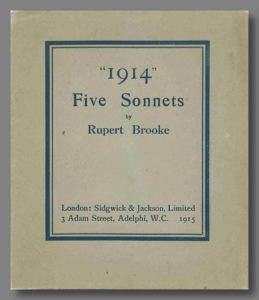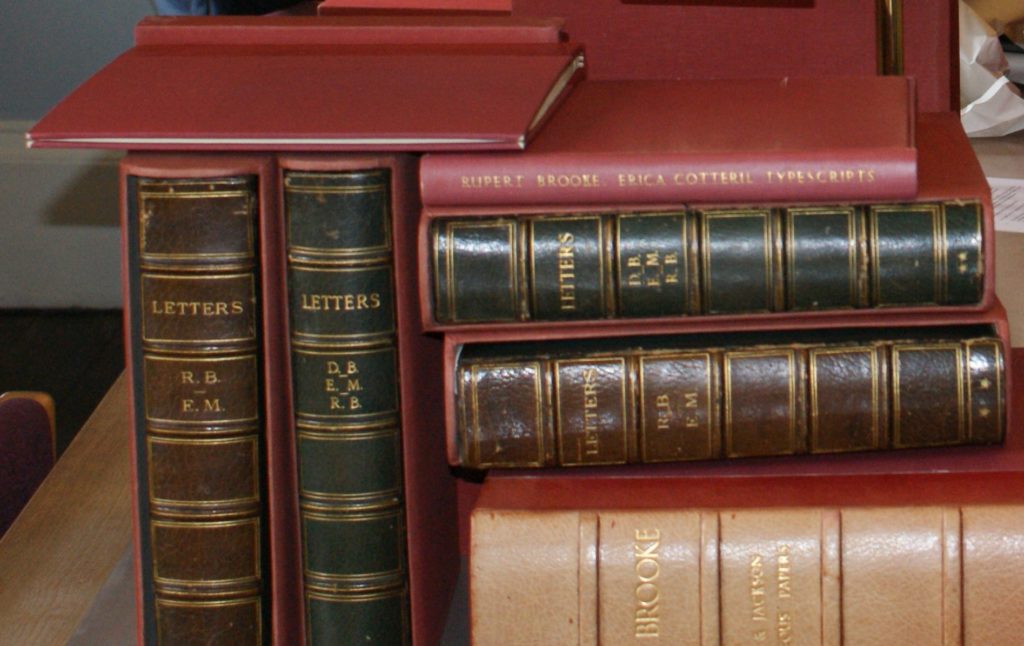Our friend Laurence Worms, blogging as the Bookhunter on Safari, has written another of his must-read posts, this time on the subject of erroneous information being spread through the cataloguing of online booksellers. His case in point was 5 dealers offering copies of a pamphlet by Rupert Brooke that they all described as having been printed in an edition of 500 copies. The statement was made even though Keynes, Brooke’s authoritative bibliographer, states clearly that the number printed was 20,000, and there are no grounds for claiming otherwise.

But the title of the post, “Assertive Cataloguing,” actually points to another bookselling firm (William Reese Company) which described the book correctly and then took the opportunity to flash its torchlight upon the multitude of misinformed colleagues who are lazier than they. This juicy bit of cataloguing reads:
“First separate edition, published on 15 November in an edition of 20,000 copies — not 500 copies as is incorrectly asserted in a multitude of online listings collectively offering ample evidence of how the virus-like perpetuation of baseless misinformation originating in laziness rather than consultation with reliable authority — i.e. the standard bibliography — can quickly permeate the collective databases. “
Laurence, of course, is more delicate in his admonishments and focuses instead, and with far more devastating effect, on a the extensive bibliographic evidence available to disprove some further preposterous claims, made by three nameless “culprits,” that “this scarce pamphlet is Brooke’s third appearance in print.” The absurdity of this “third appearance” claim is relentlessly demolished, almost to the point of making me feel sorry for the unnamed and unknowing “culprits” who foolishly cribbed their info from sources that probably knew even less about Brooke than they did. Laurence, of course, named no names, but anyone curious to learn identities (as I’m sure many were) could have quickly gone to viaLibri and seen who these mistaken sellers were – provided they were quick about it. By Friday morning listings were being pulled or corrections were being made, and one imagines that before the weekend is over no more embarrassing evidence will remain to be found. (Except with Google, which takes longer to forget). This is, I’m sure, small consolation for the sellers involved, but at least this one bit of misinformation has now been removed from the internet and, one hopes, will not return.
One central thing, however, is left unresolved: where did the erroneous bibliographic information come from in the first place? This is what I really want to know. We have five booksellers who claimed that there were only 500 copies printed. Did one of them make this up and then have the other four copy him? Or did they all copy from yet other booksellers who had long since sold their copies and disappeared from scrutiny. Or could the information have first appeared in some other erroneous source, perhaps long ago, and been repeated often enough to become regarded as accepted fact that didn’t need to be verified.
Laurence, I suspect, holds the internet responsible. He is no friend of “the appalling ABE, home of bibliographical iniquity,” although in this case he notes that even the ILAB site also offered two of the copies that were incorrectly described. Several others did so as well. But I think the selling sites are not the problem. Clearly neither AbeBooks nor ILAB do more than offer a platform for dealers to sell books they describe themselves. The platforms can no more be expected to vet the descriptions of the books they list than FedEx can be expected to vouch for their completeness when they deliver them.
That said, there can be no question that the internet has now become a primary vector for the transmission of error into the bibliographic record. But it is not the first such vector. In its day, paper and pencil could do the same kind of damage, and anyone now relying blindly on the accuracy of bibliographic records compiled and researched with any previous technology will be equally likely, some day, to repeat the kind of errors committed in this instance by the “’FIVE SONNETS’ Five .” We know that technologies are only as good as the people who employ them. This case is no different. What is more important is to know what can be done to improve the accuracy of all the bibliographic tools we rely on and, in our own ways, contribute to.
Laurence is clearly right that errors such as the one he posted about do damage to all of us as booksellers. Those who are careful and accurate may, to the novice at least, appear less knowledgeable and reliable than those who offer appealing information that just happens to be false. And we should want to do something about this. To blame the internet for bibliographic errors is blaming the messenger. Errors will certainly propagate on the internet, but they will also be exposed there and hopefully, in time, eliminated. This is what has happened here. Those with real knowledge exposed to scrutiny the bibliographic errors of others and helped save future bibliophiles from these probably innocent mistakes. This is a process that we can expect to continue, especially if those booksellers who are knowledgeable will make an effort, like the William Reese cataloguer, to draw attention to errors as they surface.
In fact, I’m inclined to believe that the internet has already been protecting collectors from the type of errors we are talking about, even before corrections are made. Consider this example. If we assume, as I do, that the mistake about the 500 copies is older than the internet, then we have to wonder what would have been the consequence for a pre-internet buyer who was offered a copy of “1914” FIVE SONNETS that had been incorrectly described. That buyer would logically assume that a fragile 8 page pamphlet by a highly collected author, published in an edition of only 500 copies, would almost certainly be rare. And he would have paid a high price for it. Even the bookseller, who might not own a copy of Keynes, would have no reason to think it should be otherwise. But the same buyer today, presented with the same pamphlet and the same claims, would only need to look on viaLibri to find over a dozen copies for sale. This would give him hard evidence that the item was not rare at all, in spite of the claims of the seller. And it would give a seller no protection for claiming rarity that was not, in fact, the case. It seems to me that this new reliance on the quantifiable evidence of online search engines has come to replace reliance on the assertive claims of rarity that dominated before our time. This is probably not the sense of “assertive cataloguing” that Laurence had in mind when he put this title on his post. However, if he is looking for a good tag to use when he teaches his new class of cataloguers about the perils they must avoid, then I think it might be just the thing. But the biggest peril of all, of course, is copying someone else’s “research” without verifying its accuracy on your own. And on this score professor Worms has presented an excellent lesson for all of us.

